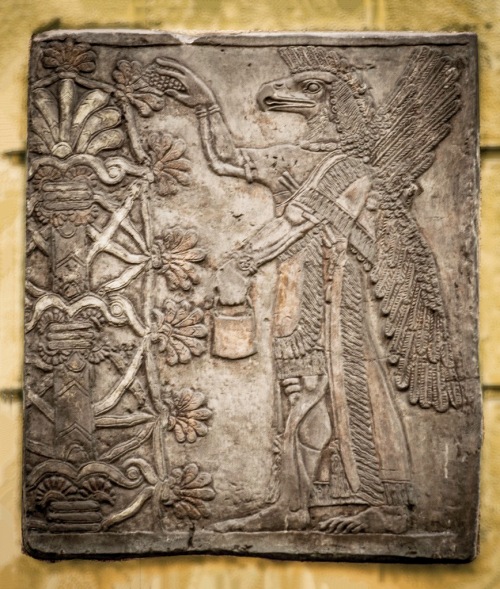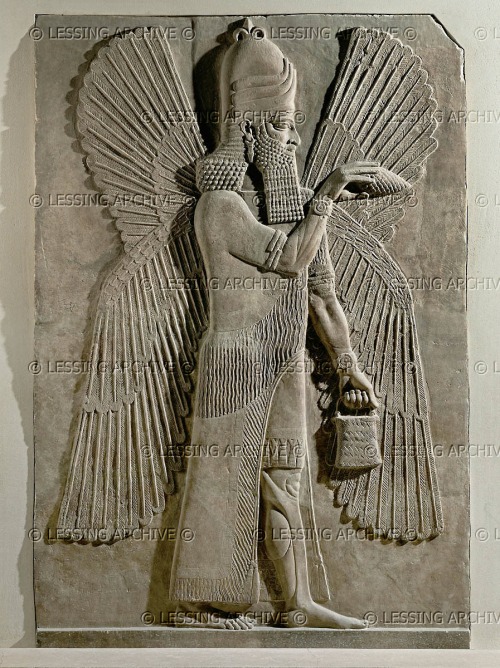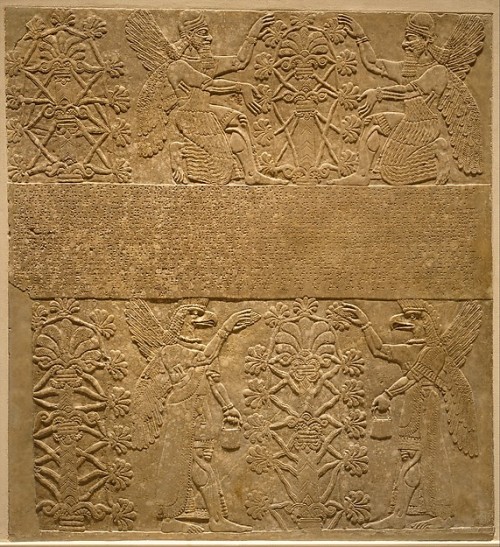Kvanvig: The Apkallu are on the Borderline Between the Human and the Divine
“Our assumption is therefore that there existed two versions of the Adapa Myth in the Nineveh archives. Since the Nineveh fragments C and E follow fairly close to the Amarna text in fragment B where they overlap, we suppose, as quite commonly in scholarship (sic), that a story like fragment B was known to the Assyrian scholars.
At the same time they had received, or composed themselves, a different version of the outcome of the story: Adapa was not returned to the earth, but remained in heaven as the ultimate sign of divine wisdom.
We use this hypothesis as a backdrop for the following discussion of the relationship between the Adapa Myth and Bīt Mēseri, being aware of the possibility of other explanations of the close similarities between the texts.

The three types of apkallū are portrayed, with the human ummânū at far left, the Nisroc bird-apkallū type in the middle, and the antediluvian purādu-fish type at far right.
The human ummânū is attested in the Uruk List of Kings and Sages, while other references to bird-apkallū are legion, as documented in Wiggermann and other authorities.
The purādu-fish apkallū is principally attested in Berossus, though other authorities confirm them, as well.
The anthropomorphic qualities of the purādu-fish and the Nisroc apkallu remain unexplained, though the eagle is sacred to Enki / Ea.
The place where the connection between Bīt Mēseri and the Adapa Myth is most clear is in the fate of the seventh apkallu. According to Bīt Mēseri he is described as: utuabzu ša ana šamê ilū, “Utuabzu, who ascended to heaven” (I. 9).
In the subsequent list it is said about the same apkallu that he descended from heaven. In the myth an essential part of the plot is that Adapa, because of his interruption of the divine order by breaking the wing of the South Wind, had to ascend to Anu: a[n]a šamê īt[ellim]a, “he ascended to heaven,” repeated in the next line: ana šamê ina ēlišu, “when he ascended to heaven” (Amarna fragment B rev. 37-38).
As we have already seen, the final fate of Adapa, according to fragment B, was that he was sent back to the earth. So there are good reasons to assume that the fate of Adapa according this version of the myth is reflected in the seventh sage in Bīt Mēseri.
There are descriptions similar to the one of the seventh apkallu connected to all the apkallus in the list of Bīt Mēseri. The descriptions connected to the first seven are very brief; those connected to the next four are a bit longer, almost like a line from a story.
If we for the moment exclude the first apkallu, to whom we will return, the problem is that we do not know what these descriptions refer to. If we use the description of the seventh apkallu as a point of departure, especially the longer ones could in the same manner be allusions to stories known to the readers.
(Cf. V.A. Horowitz, “Tales of Two Sages—Towards an Image of the “Wise Man” in Akkadian Writings,” in Scribes, Sages, and Seers: The Sage in the Eastern Mediterranean World, ed. L.G. Perdue. Göttingen 2008, 64-94, 66.)

In Neo-Assyrian art these bird-headed “genies,” as they were long described, are now known to be apkallū, “bird-apkallū,” in this case, mixed-feature exorcists and creatures of protection created by the god Ea. They traditionally served as advisors to kings. Their association with sacred trees, as they are often portrayed, remains somewhat perplexing.
This apkallū makes the iconic gesture of exorcism and liberation of sin with the mullilu cone in his raised right hand, and the banduddu water bucket in his left hand.
There are three known types of apkallū: the human, with wings; the avian-headed, with wings, and the fish-apkallū, with carp skin draped over their heads.
https://www.flickr.com/photos/lanpernas2/8606000868/
There is a common denominator in these allusions; they all tell about quite extraordinary events, demonstrating the power of the apkallus:
“14-15: Nungalpiriggaldim, the apkallu of Enmerkar, who brought down Ištar from heaven into the sanctuary;
16-17: Piriggalnungal, born in Kiš, who angered the god Iškur / Adad in heaven,
18-19: so he allowed neither rain nor growth in the land for three years;
20-23: Piriggalabzu, born in Adab / Utab, who hung his seal on a “goat-fish” and thereby angered the god Enki /Ea in the fresh water sea, so that a fuller struck him with his own seal;
24-25: the fourth, Lu-Nanna, two-thirds apkallu,
26-27: who expelled a dragon from É-Ninkiagnunna, the temple of Ištar and Šulgi;”
(Bīt Mēseri III, 14’-27’).
In two of the cases it is said that this power angered the gods: Pririggalnungal angered Adad and Piriggalabzu angered Ea. In these cases there is an analogy to the Adapa Myth.
Adapa was equipped with the power of speech, so when he cursed the South Wind, the curse became reality, the wing was broken, and the Wind was paralyzed. This interruption of the divine order angered Anu in heaven, which was the reason why Adapa had to ascend to heaven to appease him.
There is, accordingly, something ambiguous in this power. The apkallu exist on the borderline between the human and the divine. They can overstep this line and trespass into the realm of the divine, and thus anger the gods.
On the other hand, this is not purely negative; if so it would hardly have been included in the text; the power reveals the fearless and courageous nature of the apkallus, certainly necessary when they shall fight the terrifying demons.”
Helge Kvanvig, Primeval History: Babylonian, Biblical, and Enochic: An Intertextual Reading, Brill, 2011, pp. 123-5.



